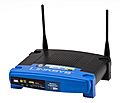IEEE 802.11 facts for kids
IEEE 802.11 is a set of rules, called protocols, that help computers and other devices connect to each other without using wires. You probably know it better as Wi-Fi or Wireless LAN (WLAN). Wi-Fi lets your computers, phones, and tablets talk to each other and the internet using radio waves, just like a radio or TV. There are many different types of Wi-Fi, like 802.11a, b, g, n, ac, and ad. Each type offers different speeds and can reach different distances.
Contents
How Wi-Fi Standards Developed
The very first Wi-Fi standard, called IEEE 802.11, was created in 1997. It allowed devices to communicate at speeds of 1 to 2 megabits per second. This speed is very slow by today's standards, so this original version is rarely used anymore.
Newer and Faster Wi-Fi
After the first standard, new versions were made. These newer versions added a letter to the name, like 802.11a, 802.11b, and 802.11g. Even newer ones include 802.11n, 802.11ac, and 802.11ax (also known as Wi-Fi 6). All these different Wi-Fi standards are designed to work together.
Most modern Wi-Fi standards can reach speeds of 54 Mbit/s or much higher. However, in real life, you usually get about 40-50% of that speed. This is because of things like distance, walls, and other devices. Around 2007, 802.11g and 802.11b were the most common types of Wi-Fi. Today, 802.11n and 802.11ac are very popular.
How Wi-Fi Uses Radio Frequencies
Wi-Fi sends data using radio waves, similar to how a radio station broadcasts music. These radio waves travel on specific "lanes" called frequency bands. The two main bands for Wi-Fi are 2.4 GHz and 5 GHz.
The 2.4 GHz Band
The 2.4 GHz band is a common frequency used by many devices. Things like microwave ovens and Bluetooth devices also use this band. This can sometimes cause problems because there are only a few "channels" that Wi-Fi networks can use without interfering with each other.
There are only three channels in the 2.4 GHz band that can be used at the same time without signals getting mixed up. If more than three Wi-Fi networks are operating in the same area, their signals can still reach you. However, this interference can make your internet connection slower.
The 5 GHz Band
The 5 GHz band helps solve some of the interference problems found in the 2.4 GHz band. It has many more channels, usually around 19, that can be used. This means less crowding and potentially faster, more reliable connections.
However, the 5 GHz band also has its own rules. Devices using this band often need to be able to pick the best channel to avoid interference. Some channels also require devices to use something called Transmitter Power Control. This means the device adjusts how strong its signal is to use only what's needed. This helps reduce interference between different Wi-Fi networks even more.
Images for kids
See also
 In Spanish: IEEE 802.11 para niños
In Spanish: IEEE 802.11 para niños





